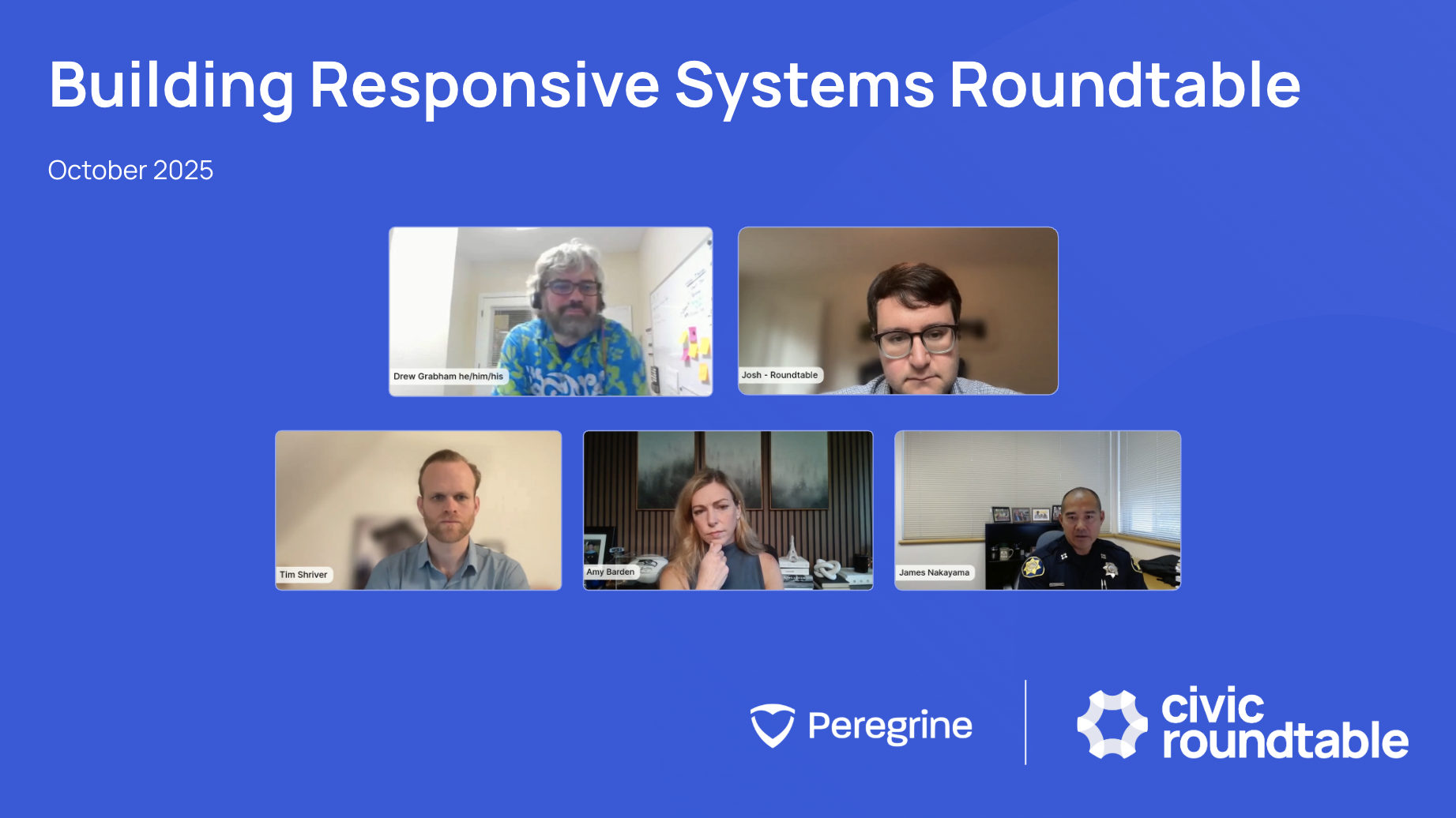
Across the country, frontline workers in human services, behavioral health, housing, and public safety fight an uphill battle to respond effectively to crises involving mental illness, substance use, or homelessness. While nearly 20% of 911 calls involve mental health crises and over 60% are noncriminal, systems responsible for follow-up — from mobile crisis teams to housing case managers — operate in silos, hindering coordinated support. The infrastructure connecting these efforts lags behind urgent needs.
Last week, we co-hosted a Roundtable with Peregrine, a public safety data platform, featuring leaders advancing innovative models that connect human services, behavioral health, and public safety. Panelists Drew Grabham (Central City Concern, Portland), Captain James Nakayama (Concord Police Department), and Dr. Amy Barden (Seattle CARE Department) explored how communities leverage networks of coordination, cross-agency workflows, and real-time communications to deploy appropriate responses, reduce fragmentation, and support residents compassionately during and after crises.
As Josh Seiden, Roundtable cofounder, explained in opening remarks, his experience prior to Roundtable supporting communities with public safety technology made clear to him the need to bridge the silos that make it harder for public servants across organizations to work together on these problems.
These essential conversations remain too rare. People experiencing homelessness, mental health crises, and substance use disorders don't fit neat bureaucratic categories. The systems and people helping them must find easier ways to collaborate.
One of the clearest insights was that no single agency has the responsibility — or ability — to handle behavioral health crises alone. There's often complex structural, economic, social, and behavioral health contributors to behavior behind a 911 call. Nearly everyone in crisis has already tried to access services unsuccessfully.
Grabham’s street outreach team in Portland prioritizes relationships, trust, and complexity over a one-size-fits-all approach. They build relationships over 10 years and hire former clients as peer workers. Dr. Barden explained how Seattle's CARE department is integrated directly into dispatch.
These models succeed because they reject silos. But making this work requires coordinating across front line services — behavioral health providers, social services, public safety, fire departments, hospitals, shelters, and outreach teams — all needing visibility into who they're serving and what's already happened.
The most critical question in crisis response, according to Dr. Barden, isn't about demographics or call volume. It's: "Who knows this person best?"
Captain Nakayama described Contra Costa County's A3 Program, a three-tier response system ranging from peer support calls to emergency co-response with law enforcement and clinicians. Drew Grabham’s team builds relationships over time because trust and context matter. They know what's been tried, what works, and what doesn't.
Yet this crucial context is often lost. When public servants can't access historical information or relationship history, they're forced to start from scratch — or provide the same inadequate response: "Here's a list of places, go do it, good luck."
The results of integrated approaches are heartening. Concord saw a 41% decrease in mental health-related calls that officers respond to. Grabham’s work has contributed to drops in 911 calls generated from the highest utilization individuals after sustained engagement.
This coordination and integration doesn’t just result in more effective outcomes. When you compare program costs to ongoing crisis response, emergency visits, and incarceration, the case for change is clear.
As Dr. Barden noted in the discussion, there's a groundswell movement happening — one anchored in compassion and a shared commitment to doing better. A more connected environment, where every partner who matters to the mission has the context they need — from first responders to social services to coordinated entry—is critical. The opportunity now is to build the technological infrastructure that public servants deserve to sustain this momentum.
These opportunities to empower public servants are what motivates our work. With Roundtable, coordinating agencies consolidate communications channels, centralize fragmented knowledge, and give disconnected frontline providers a rich partner ecosystem for peer learning and real-time information sharing.
That’s why we’re trusted by New Jersey to power statewide coordination to end veterans homelessness, and by Arizona to provide the operational backbone connecting its Extreme Heat Preparedness Network. It’s an honor to support public servants tackling the most challenging, critical issues facing society.
Learn more about how Roundtable can transform your operations.